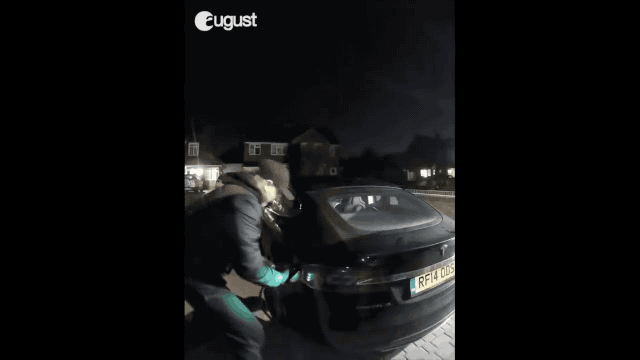Earlier this week a Tesla owner in Essex, Great Britain, posted security camera footage of his Model S being stolen by a pair of thieves who were able to unlock and start the car with a smartphone and a tablet.
By hijacking the owner’s key fob, they were able to get in, turn on the car, disable remote tracking and make off with his fancy ride!
While “keeping your Tesla safe” may be one the bougiest of problems we’ve ever tackled, many cars use keyless entry and thus present similar security issues.
As The Verge points out, a number of car manufacturers, including Volkswagen and Mercedes, have had to contend with tech-savvy car thieves exploiting security loopholes in their key fobs for years.
So what can you do to keep your Musk-mobile safe? There are a couple of ways to optimise Teslas to keep them safe from high-tech hijacking and a some of broader tips that will help keep any car with keyless entry safe.
Enable ‘PIN to Drive’
Earlier this year, Tesla added two-factor authentication to the Model S and Model X to block thieves who manage to spoof a key fob. Tesla’s PIN to drive feature requires drivers to type a four-digit code into the car’s central computer to start the engine.
To activate PIN to Drive on a Tesla’s centre screen, select Controls, then Safety and Security, and finally “PIN to Drive”, then follow the instructions.
We always recommend using two-factor authentication whenever you can. Even in your car.
Tesla forum users have expressed concern that a four-digit code feels guessable, especially if a thief is able to infer the digits in your passcode by looking at fingerprint smudges.
That isn’t as big a concern as you might think — the central console is used for plenty of things besides typing in your passcode, so it probably isn’t obvious which smudges are from you typing in your pin or just changing the radio station.
Still, if you want to be absolutely certain, make sure to wipe down the touchscreen often. Or put on driving gloves before starting your car.
Disable Keyless Entry
If the video has you spooked to the point where you’re willing to sacrifice a little convenience in the name of security, Tesla gives you the option to turn off keyless entry, which unlocks your doors when the fob gets close.
To disable keyless entry on the Tesla’s centre screen, tap “security”, then “doors and handles”. From there, you can switch the “keyless entry” off. In the same menu, you can also disable the “auto-present handles” feature, which flips up the car’s door handles when your fob is in range.
These are relatively minor preventative measures — Even without keyless entry, thieves can break into your car the old fashioned way and they’ll still be able to start the car by spoofing the fob once they’ve let themselves in. Still, disabling keyless entry will make your car harder to steal and increase the chances that they get spotted in the process, so that’s something.
Store your keys in a Faraday Cage
In the video, it appears that the thieves activated the car by finding the frequency used by the key fob using a phone and extending its detection range with a tablet.
You can make it impossible for someone to clone your fob’s signal by putting your keys in a sealed metal container, AKA a Faraday cage, which will block incoming and outgoing electronic signals.
It’s very easy to find or make your own RFID-blocking container.
You can turn any metal container into a Faraday cage by lining it with aluminium foil and sealing it with aluminium tape.
If you want something more fashionable, you can always buy an RFID-blocking Faraday bag: There are a ton of them out there and Tesla forum-goers suggest that they generally work well.
Add a secondary GPS
Teslas have a remote GPS tracking feature, which gives law enforcement a way to track the car, “Find My iPhone”-style. Unfortunately, as we likely saw in that video, that feature can be easily disabled by a thief once they’ve started the car.
If you want to ensure to give law enforcement a slightly better chance of finding the car, you can take the Tesla to a shop and install an after-market GPS tracker in/on your car. There are a many GPS devices available on Amazon, which either plug into your car’s OBD port or can be stashed anywhere in the car.
Most of them are pretty cheap — especially relative to the cost of a Tesla — though they saddle you with a monthly or annual fee for the service.
There are ways for a careful car thief to circumvent these trackers as well, such as a GPS jammer, but if they know that Teslas have built-in remote tracking, they may be less likely to take those steps. See? Car owners can be sneaky too.
Plug your car in
The biggest hurdle to Tesla thieves in the video wasn’t an alarm or a fancy security feature — it was the freaking charger! They spent more time trying to disconnect the Tesla from the house than breaking into the car.
Since electric vehicles are not incredibly common and their maintenance is not ubiquitous, forcing a thief to unplug your car does double as a preventative security measure.
This may not stop a knowledgeable and/or well-prepared thief, but it tripped up these guys and they seemed to have their act together.

Leave a Reply
You must be logged in to post a comment.